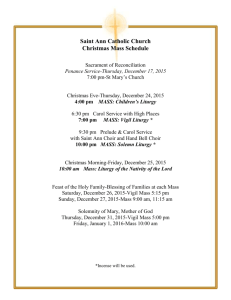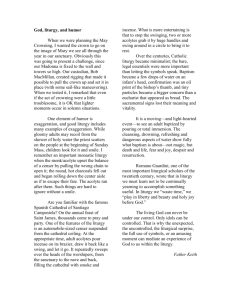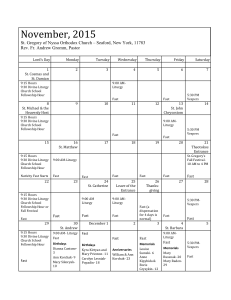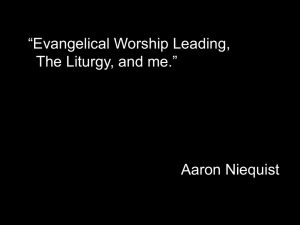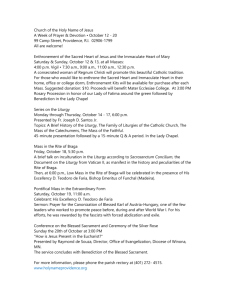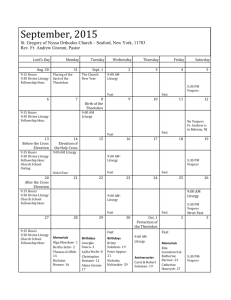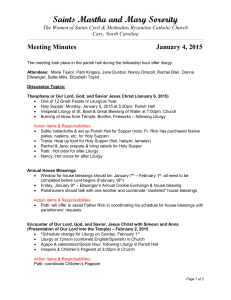Bulletin_20
advertisement
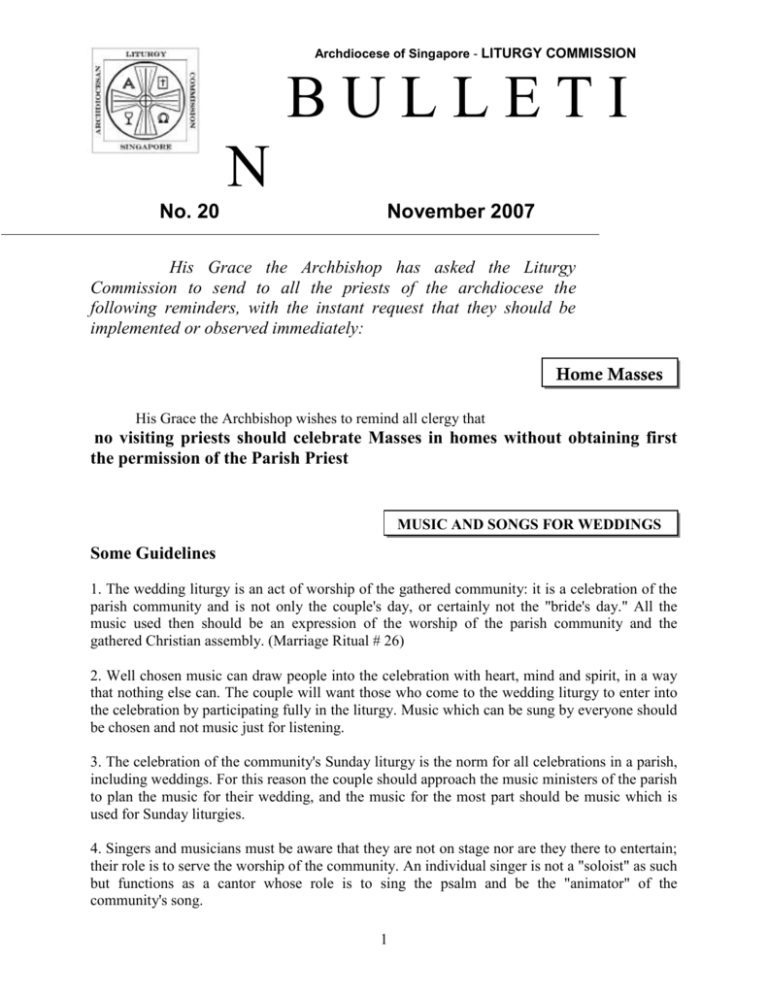
Archdiocese of Singapore - LITURGY COMMISSION BULLETI N No. 20 November 2007 His Grace the Archbishop has asked the Liturgy Commission to send to all the priests of the archdiocese the following reminders, with the instant request that they should be implemented or observed immediately: Home Masses His Grace the Archbishop wishes to remind all clergy that no visiting priests should celebrate Masses in homes without obtaining first the permission of the Parish Priest MUSIC AND SONGS FOR WEDDINGS Some Guidelines 1. The wedding liturgy is an act of worship of the gathered community: it is a celebration of the parish community and is not only the couple's day, or certainly not the "bride's day." All the music used then should be an expression of the worship of the parish community and the gathered Christian assembly. (Marriage Ritual # 26) 2. Well chosen music can draw people into the celebration with heart, mind and spirit, in a way that nothing else can. The couple will want those who come to the wedding liturgy to enter into the celebration by participating fully in the liturgy. Music which can be sung by everyone should be chosen and not music just for listening. 3. The celebration of the community's Sunday liturgy is the norm for all celebrations in a parish, including weddings. For this reason the couple should approach the music ministers of the parish to plan the music for their wedding, and the music for the most part should be music which is used for Sunday liturgies. 4. Singers and musicians must be aware that they are not on stage nor are they there to entertain; their role is to serve the worship of the community. An individual singer is not a "soloist" as such but functions as a cantor whose role is to sing the psalm and be the "animator" of the community's song. 1 5. When making choices, there are several points to keep in mind. The selection should fit its particular function in the liturgy: Introductory Rites and Liturgy of the Word - The Entrance Song should be a joyful song of praise and thanksgiving to God. This song may be sung during the procession or after the procession has been completed. MR# 26; 38; 46) - The Responsorial Psalm which follows the first reading is an important sung part of the liturgy. There are various settings of Psalm 128, (a recommended one for weddings). There are also suggestions for other psalms in the lectionary. The cantor sings the verses and invites the assembly’s sung response as at a Sunday liturgy. - The Gospel Acclamation is sung before the proclamation of the gospel. Led by the cantor or choir the setting chosen should be a familiar one and appropriate for the liturgical season. Liturgy of the Eucharist - The acclamations of the Eucharistic Prayer: Holy, Holy; Memorial Acclamation; Great Amen are meant to be sung. Singing the setting of these used at the parish Sunday liturgy or another well-known one will make it easier for the assembly to sing. The same applies to the Lamb of God. - The Lord's Prayer is everyone's prayer and should never be sung by only one person. If it is to be sung by the whole assembly, use a setting everyone knows. Otherwise use the spoken prayer. - The Communion Song should be about what the community is doing: receiving Communion. Any other songs, especially a soloist singing "Ave Maria" or any other Marian song should NOT be used during the communion rite. - If a couple wishes to use a Marian song, or another religious song that does not function within the liturgy, it may be used either before the liturgy begins or during the signing of the register. Songs which are not liturgical should be examined carefully to ascertain the appropriateness of the text. (MR # 26) You may wish to apply the following questions to check out the suitability of a text: Will this song help all present to open themselves to God: will it enhance the worship or be a distraction? Do the words express a Christian view of love, or a shallow, soap-opera view? Are they theologically sound, and are they fitting for the celebration of a sacrament of the Church? Does the song fit the part of the liturgy for which it is intended? Does the music draw people into real participation or does it invite them to become mere listeners? Is the song within the capabilities of those singing and playing it? In general: • Even if a love song mentions God, it may not be appropriate for an act of worship; an expression of a love that focuses on the physical and emotional aspects is not what the love of 2 God for God’s people is about. Words which use the first person (for example, the bride and groom addressing each other) are not appropriate for public prayer. Songs from the entertainment world are almost never suitable for the wedding liturgy. MR # 26 • Melodies, too, should be considered carefully. People are actually more easily influenced by the music than the words, because the influence is often unconscious. Tunes which originate in stage or screen productions can insidiously subvert the Christian mystery of love. Simply changing the words of a song is not sufficient to make it suitable. MR # 26 • There may be songs, especially love songs, which are very significant for a couple. These need not be used in the liturgy but can be used at some other time during the wedding day, e.g. during the reception or at the banquet. • Instrumental music also has a place in the wedding liturgy, e.g. the processional (which can be followed by an entrance or a gathering hymn) and the recessional. The "soap opera" wedding is not a good model for the Christian marriage liturgy. For example "Here Comes the Bride" and Mendelssohn's "Wedding March" even in their original context have nothing to do with Christian marriage. • Taped music and any other form of pre-recorded music is not acceptable for the liturgy. The liturgy is the action of the people there to worship, and music which is not "live" music contradicts this principle. • A couple should both be involved in planning the music, together with the music ministers of the parish. It is best that the couple choose the readings for the liturgy first, and then let the selection of music flow from the readings. Songs unacceptable for the wedding liturgy “What is being brought to expression in a wedding liturgy is the mystery of human love as a covenant relationship. Songs which express the religious dimension of love explicitly, of course, have pride of choice. Songs which imply this religious dimension are also suitable. But a song which denies this dimension either explicitly or implicitly must be avoided at all costs, for it belies the mystery: it is falsehood in liturgy.” MR # 26 The songs of the liturgy should express praise of God and speak of the love of the Lord for God's people; songs that focus only on the love of the couple for each other do not express the love of God in the same way. There are always new songs that become popular, and keeping such a list up to date is not possible. These songs are better at some other part of the festivities i.e. the reception. Any instrument or group of instruments may be used in Catholic liturgy provided these instruments add dignity and a sense of celebration to the liturgy and do not distract from it. However, organ music is still the most popular instrument for weddings. . It is recommended also that there be music before the liturgy starts, preferably instrumental music, either in total or intermingled with sung pieces. The music chosen can help to create a spirit of joy, anticipation and reverence for what is about to happen. An organist can be encouraged to continue playing also as the guests leave the church building. (These notes summarise a publication from the Archdiocese of Ottawa - February, 2002) A list of entrance songs, responsorial psalms, Gospel acclamations, offertory, communion and “missioning” songs, selections for choirs and suggestions for music before 3 the service, processional music and recessionals can be obtained from the Liturgy Commission or the Liturgical Music Committee (LMC) Guidelines for PowerPoint presentations The use of PowerPoint to replace missals/hymn books in church is a recent development. It is to be found in a number of churches. The way it is done calls for the following remarks prepared by Mrs. Bernice Conceicao In preparing the templates for projection, the spirit of the general guidelines for the Eucharistic celebration as embodied in the General Instruction of the Roman Missal should be observed. Power point presentations rely on the visual to impact the message and care is required to ensure that the message is correctly and appropriately conveyed and “do not distract the faithful’s attention from the celebration itself” Animation should not be used at any time for obvious reasons. Clipart should not be used as it is inappropriate for a church setting. The celebration of the Eucharist calls for a higher form of art which is available. The pictures selected should be appropriate and tasteful. For example the illustration of the naked Adam and Eve in Genesis requires a depiction which will not distract or offend the most sensitive of souls. Nor should there be a picture of the Host with spots of blood on it – as this is both garish and ‘falsely promotes simplistic piety” to quote a recent direction. Another example of inappropriateness is a picture of the Last Supper with the caption “Who can this be that even the winds and waves obey him” used to illustrate the Gospel account of Christ walking on the water. This can cause confusion in the mind of the uninitiated. There are several pictures available which illustrate the calming of the storm, Peter walking on the water, Christ walking on the water and Christ saving Peter from sinking. It is better not to use any picture than to use an inappropriate one. Power point presentations should fall in line with the Church calendar. Therefore pictures which illustrate Lent and Passiontide, Eastertide and the Advent and Christmas events should be used within the respective seasons. Crosses decorated or entwined with lilies are Easter crosses and should be kept within the Easter Season from Easter Sunday up to the Saturday before Pentecost. In one church, an Easter cross was incorrectly used during the Easter Vigil and it sometimes appears during Ordinary Time. During Advent and Christmas all pictures with the figure of the crucified Christ should be omitted. Just as we do not sing Lenten music during Advent and Christmas, pictorial art should observe the norm. Advent and Christmas is a season for Angels, the Nativity, the Wise Men. If you do want to use a picture of a Cross then a plain Cross without the figure of Christ would be appropriate. 4 There are a multitude of pictures of angels, some of which are specifically for the Christmas season. These Christmas angels should be used only from Christmas Eve to the Epiphany. Pictures of Christ should not be used to illustrate Old Testament readings. There are a limited number of Old Testament illustrations - several of the Exodus account, of Noah and a few of the prophets. For a more finished presentation, the background of the picture used (if it is not stretched to cover the entire template) should be formatted to blend with the background of the picture itself e.g. a picture of the Eucharist within a very dark brown frame is incongruous when set against a purple, blue or green background.. This requires a fair amount of time and attention to detail. “The image of Christ and the images of the saints are not photographs. Their whole point is to lead us beyond what can be apprehended at the merely material level, to awaken new senses in us, and to teach us a new kind of seeing, which perceives the Invisible in the visible. The sacredness of the image consists precisely in the fact that it comes from an interior vision and thus leads us to such an interior vision.” (The Spirit of the Liturgy - Cardinal Joseph Ratzinger) Power point is not a gimmick nor should it become a distraction or entertainment. When used correctly it could be a powerful way to help the worshipping community to live the Eucharist and the AVA Ministry is tasked with this mission. NB: These guidelines have already be given to those involved in the AVA ministry. Judging by what is still being done in some places, the message is still largely ignored and the result is disastrous: the presentation becomes an entertaining show and the screens in church attract more attention than the altar. This is an abuse that needs to be corrected immediately by the priests concerned. The Archdiocesan Liturgy Commission November 2007 5
